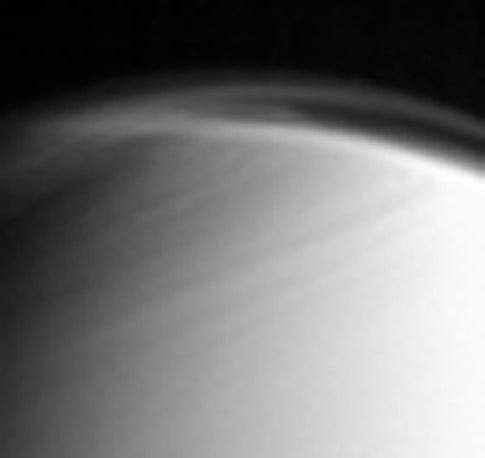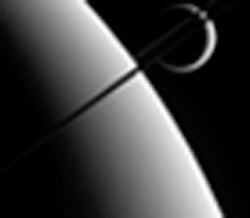Organic haze in the atmosphere of Saturn’s moon, Titan, is similar to haze in early Earth’s air — haze that may have helped nourish life on our planet– according to a NASA Astrobiology Institute study released Nov. 6, 2006.
Study scientists simulated both the atmospheric conditions of early Earth and those of present-day Titan. Their study, “Organic Haze on Titan and the Early Earth,” describing the scientists’ work, appears in Proceedings of the National Academy of Sciences. The principal author is Melissa Trainer, a NASA Astrobiology Institute postdoctoral fellow at the University of Colorado, Boulder.
According to the study’s researchers, their experiments help scientists interpret observations of Titan’s atmosphere from NASA’s Cassini mission, while also showing how a major source of organics could have been produced on Earth billions of years ago.
The researchers reported that the aerosols produced in the laboratory could serve as analogs for the observed haze in Titan’s atmosphere. The scientists also estimated that aerosol production on early Earth could have served as a primary source of organic material to the surface.
“This paper shows one of the ways in which the study of other worlds can help us understand Earth,” said Chris McKay, a scientist at NASA Ames and one of the study’s co-authors. “Titan has a thick organic haze layer, and this work started out to understand the chemistry of that alien organic haze. Then we realized that we could apply the same approach to the organic haze on early Earth.”
“We hope to determine how the organics were made and their chemical nature,” McKay observed. The scientists reported that when sunlight hits an atmosphere of methane and nitrogen, like the atmosphere of Titan today, aerosol particles form. When an atmosphere also contains carbon dioxide, as in the atmosphere of ancient Earth, different kinds of aerosols form.
The scientists used a special ultraviolet-light lamp to produce particles in the simulated atmospheres, and measured the chemical composition, size and shape of the resulting particles.
“It’s somewhat similar to the smog in Los Angeles,” Trainer explained. “Today’s haze on Earth is also created photochemically, which means sunlight powers chemical reactions in the atmosphere. However, the early atmosphere of Earth had different gases present, so chemical composition of the early haze is very different than the haze we have today. There also would have been a lot more of it.”











